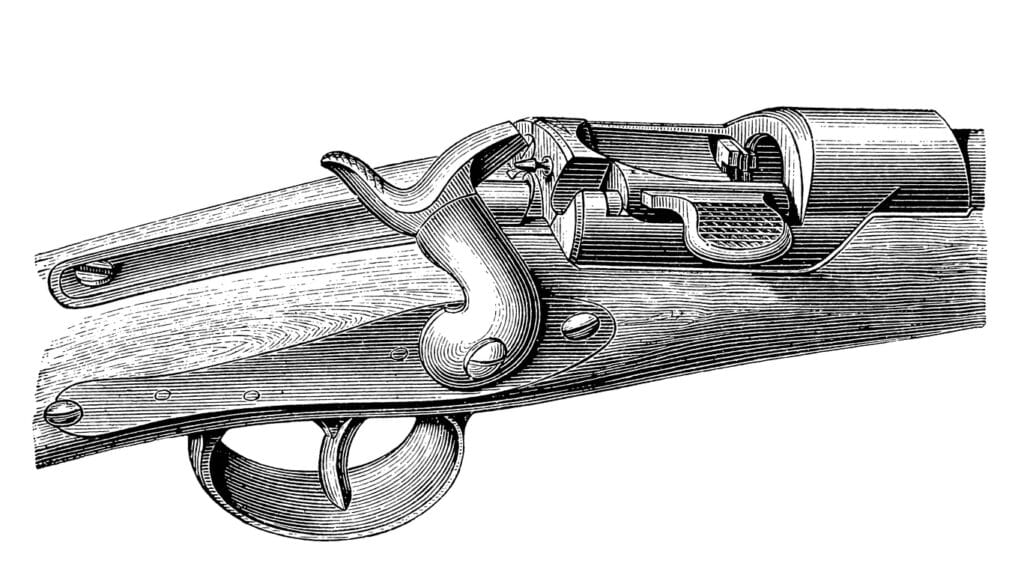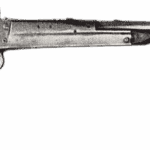
The Werndl-Holub M1867 Rifle: Austria-Hungary’s Bold Leap into the Breech-Loading Era
When the smoke of the mid-19th century battlefield began to clear, and the echoes of percussion-capped volleys faded into history, military minds across Europe faced a new imperative: modernization. The age of muzzle-loading muskets was over. In its place emerged the metallic cartridge, the breech-loading rifle, and a technological arms race among Europe's great powers. In this crucible of innovation, the Austro-Hungarian Empire produced one of its most mechanically original and forward-thinking service rifles—the Werndl-Holub M1867.
This rifle was more than a stopgap between flintlocks and repeaters. It was a defining expression of industrial ingenuity in a rapidly modernizing army. Elegant in its design, rugged in the field, and uniquely Austrian in its engineering, the Werndl-Holub M1867 was the Austro-Hungarian Empire’s first standardized breech-loading military rifle and marked a turning point in Central European military armament.
Origins and Inventors: Josef Werndl and Karel Holub
The Werndl-Holub rifle was born of collaboration between two visionaries: Josef Werndl and Karel Holub.
Josef Werndl, the son of a gunsmith and heir to the legacy of the Österreichische Waffenfabriks-Gesellschaft (OEWG)—later known worldwide as Steyr—was a pioneering industrialist with a keen eye for modern production methods. After his education and apprenticeship, Werndl traveled extensively across Europe and the United States, observing emerging armament technologies. By the 1860s, he returned home determined to transform Austria-Hungary's aging arms manufacturing capabilities into a modern arsenal.
Karel Holub, an artillery officer and inventor in the Imperial army, was the mind behind the rifle's central mechanical innovation: the rotating breechblock. His “turn-block” system provided a secure seal and robustness that rivaled, and in some cases surpassed, many contemporary breech-loading mechanisms.
Their joint design would eventually become the M1867 Werndl-Holub rifle—accepted into service following rigorous testing by the Austrian military in the wake of the empire’s sobering defeat by Prussia at Königgrätz in 1866.
Design Features: The Turn-Block Action

At the core of the Werndl-Holub M1867 lay its most distinctive feature: the rotating breechblock, or turn-block mechanism. Unlike the Snider-Enfield’s hinged side gate or the American Trapdoor Springfield’s upward-swinging block, the Werndl’s breechblock pivoted horizontally on a central axis, revealing the chamber with a quarter-turn motion.
This turn-block was machined from a single block of steel, rotated via a thumb-lever on the right-hand side of the receiver. Once opened, the operator inserted a metallic cartridge into the chamber, rotated the block shut, and cocked the external hammer for firing. The design was formally recognized in U.S. Patent No. 74,737, granted to Josef Werndl on February 18, 1868. The patent’s detailed diagrams depict the full mechanics of the rotating breechblock and highlight the design’s emphasis on strength, simplicity, and reliable gas sealing—attributes that would prove essential in black powder military rifles.
While marginally slower than rolling-block or bolt-action designs, the Werndl’s robust construction and mechanical integrity made it exceptionally durable under field conditions.
Specifications (Infantry Rifle Model):
- Caliber: Initially 11×42mmR rimfire, upgraded in 1877 to 11×58mmR centerfire.
- Barrel Length: 33.1 inches (840 mm)
- Overall Length: 51.4 inches (1,305 mm)
- Weight: Approx. 9.9 lbs (4.5 kg)
- Action Type: Single-shot, rotating breechblock
- Rate of Fire: 8–10 rounds per minute (trained soldier)
- Muzzle Velocity: ~420 m/s (1,377 ft/s) with centerfire load
Ammunition Evolution: Rimfire to Centerfire
The original M1867 Werndl chambered the 11×42mmR rimfire cartridge, a metallic-cased round that represented a significant step forward from the paper cartridges of earlier decades. However, rimfire cartridges—despite their ease of ignition—suffered from inconsistent extraction, reduced reliability, and limited reloadability.
Recognizing this, Austria-Hungary reengineered the rifle in 1877 to accept the more modern and potent 11×58mmR centerfire cartridge. This round not only offered more reliable ignition and easier extraction but also improved ballistic performance and longer effective range.
Ballistic Comparison:
| Cartridge | Bullet Weight | Muzzle Velocity | Effective Range |
|---|---|---|---|
| 11×42mmR Rimfire | 370–400 grains | ~390 m/s | ~300 meters |
| 11×58mmR Centerfire | 385–410 grains | ~420 m/s | 600+ meters |
This switch placed the Werndl on par with the most powerful infantry rifles of the era, including the British .577 Snider and the French 11mm Gras.
In the Field: Service and Deployment
The Werndl-Holub M1867 entered active service across the Austro-Hungarian Empire shortly after adoption. While it was never tested in a large-scale continental war—Austria remained relatively peaceful during its service period—it was deployed in numerous colonial engagements, Balkan border conflicts, and internal military policing operations.
Infantry troops were issued the standard long rifle variant, while artillery and cavalry units received shorter carbines and engineer rifles. Its robust construction made it well-suited to harsh field conditions, and it earned a reputation for reliability and accuracy within the ranks.
From 1867 to its gradual phase-out beginning in 1886, the Werndl remained the Empire’s principal service rifle. It was ultimately superseded by the Mannlicher M1886 and later M1888 straight-pull repeaters, which offered magazine-fed firepower and dramatically improved rates of fire.
Still, the Werndl was never truly forgotten. Thousands of rifles were retained in second-line units, arsenals, and colonial outposts well into the 1890s. Many were sold on the civilian market or modified for hunting, and they continued to see use in the hands of sportsmen, farmers, and reservists into the early 20th century.
Comparative Analysis: Werndl vs. Its Contemporaries
To truly appreciate the Werndl’s place in history, it must be viewed in context with its contemporaries.
Werndl M1867 vs. British Snider-Enfield (1866):
| Feature | Werndl M1867 | Snider-Enfield |
|---|---|---|
| Breech Mechanism | Rotating breech | Hinged side lock |
| Cartridge | 11×58mmR Centerfire | .577 Snider |
| Action Strength | High | Moderate |
| Fire Rate | 8–10 rpm | 10–12 rpm |
| Ease of Use | Moderate | High |
The Snider’s breech was faster to operate and simpler to train, but the Werndl’s turn-block provided superior gas sealing and long-term mechanical durability.
Werndl M1867 vs. French Chassepot (1866):
| Feature | Werndl M1867 | Chassepot Mle 1866 |
|---|---|---|
| Breech Mechanism | Rotating breech | Needle-fire bolt |
| Cartridge | 11×58mmR Centerfire | 11mm Paper Cartridge |
| Gas Sealing | Excellent | Poor |
| Reliability | High | Moderate |
While the Chassepot had excellent range and rate of fire, its reliance on paper cartridges led to fouling, gas leakage, and field fragility—problems the Werndl’s metallic cartridges avoided entirely.
Legacy and Collectibility
Few 19th-century European rifles embody national identity quite like the Werndl. As Austria-Hungary’s first standardized metallic cartridge rifle, it marked the beginning of the empire’s shift into modern warfare. Its distinctive turn-block design was a proud product of Austrian mechanical philosophy—favoring solid, overbuilt, long-lasting engineering.
Today, surviving Werndl rifles are highly sought-after by collectors. Their unique action, historical significance, and limited production run—relative to other major European rifles—contribute to their desirability. Museum pieces and fully-matching serial number examples command premium prices, especially those still chambered in their original calibers.
In civilian life, many Werndls were sporterized, shortened, or converted to shotgun use during the early 20th century, particularly in rural Central Europe. Despite these modifications, many retained their hallmark rotating breechblock, serving generations beyond their military retirement.
Why the Werndl-Holub M1867 Deserves Recognition
- Innovative Design: The rotating breechblock was among the strongest single-shot actions of its time.
- Pioneering Role: First breech-loading standard rifle of the Austro-Hungarian Empire.
- Ballistic Power: Chambered for one of the most powerful black powder military cartridges of the era.
- Mechanical Integrity: Maintained serviceability well beyond its intended operational lifespan.
Conclusion
Overshadowed in modern memory by its more famous counterparts, the Werndl-Holub M1867 stands as one of the most significant transitional arms of the 19th century. It was the embodiment of Austria-Hungary’s leap from black powder age muskets into the metallic cartridge world, built not just with innovation but with industrial precision and martial purpose.
The Werndl wasn’t just a rifle—it was a bridge. A bridge between eras, between empires clinging to tradition and the rapid-fire age to come. It remains a testament to the foresight of its inventors and a compelling symbol of a lost empire's industrial might. For historians, collectors, and enthusiasts alike, the Werndl is not merely a curiosity—it is a cornerstone.
Read about the Werndl-Holub M1867 and other Austro-Hungarian weapons in action:
If you know of any forums or sites that should be referenced on this listing, please let us know here.




